Today has turned out to be very enjoyable despite it starting with some poor soul in the gents' loo suffering chronic diarrhoea and vomiting. Such can be the hazards of campsites and this is not the most savoury we have used. Concerned at the thought of crossing the North Sea feeling sick we have become neurotic about hygiene avoiding the shower block as much as possible and doing all our washing up in Modestine rather than the communal kitchens.
We took the bus down into Bergen where, near the port we have discovered a parking area for camping cars complete with facilities. It costs the same as our present campsite but is walking distance from Bergen centre. From our present site the bus fare into town is dearer than the campsite fees. Sri Lanka and Hungary provide the cheapest public transport we have ever found while Bergen is undoubtedly the most expensive. We will move Modestine down into town tomorrow morning. The new site will also be really convenient for the ferry terminal on Thursday morning. Nearby we found an old wooden corner of the city with a bronze statue commemorating the Bergen Boys' Brigade. (We saw the home of one of its founders on Monday.) This particular organisation is apparently unique to Bergen and has existed for well over 100 years. Each area of the town used to have its own brigade and the boys would drill regularly with their bows and arrows. Now the numbers have diminished but several brigades still exist around the town.
 Bergen Boys' Brigade statue and hall
Bergen Boys' Brigade statue and hall Pretty residential corner of Bergen
Pretty residential corner of BergenToday we have visited the museum of the Norwegian fishing industry down on the quay near the ferry terminal. It was a fascinating little museum with some excellent large scale model fishing and sailing boats, fishing nets, tools and equipment, historic photographs and an enormous amount of information on the different types of fish and methods used for catching them.
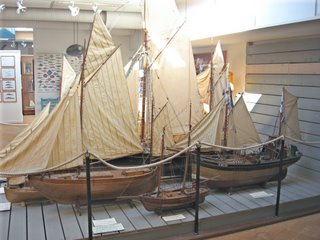 Model fishing boats in the museum of the Norwegian fishing industry
Model fishing boats in the museum of the Norwegian fishing industryThe museum also included information on where the markets for Norwegian fish could be found around the world, how the fish was dried or salted and the social background of those involved in the industry until quite recent times. The exhibition appears to have been sponsored and housed by the Norwegian fish marketing company LeRöy who have their offices in the same building.
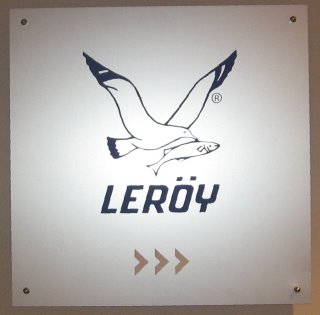 Logo of one of Norway's leading fish exporters
Logo of one of Norway's leading fish exportersIncluded specially for our French friend Joël LeRoy who fishes the Breton coast for mackerel, crabs and lobsters
This had an unexpected advantage when we discovered the company's staff canteen where we were able to eat lunch at staff rates! So we enjoyed freshly cooked baked fish with salad, coleslaw and roasted potatoes for 25 NOK each! (about £2.15) Afterwards a cup of fresh filter coffee cost us 50 pence each! Rather better value than a £7 roll or £12 for fish and chips in the market! Anyone coming to Bergen, this is the place to eat! You don't even have to go round the museum but you'd be daft not to, it's so interesting. As retired folk we were only charged 10 NOK each to get in anyway!
Next we explored Håkon's Hall and the Rozenkrantz Tower where we were again offered very advantageous entry prices as retired people even though it was not advertised. It's always worth asking. Among the many wooden buildings in Bergen these two massive stone edifices stand out from their prominent position by the harbour. They reflect the period in mediaeval times when Bergen was the capital of Norway. Both were badly damaged when a German munitions ship moored nearby exploded in 1944 but have been carefully restored. Håkon's Hall was built by King Håkon Håkonsson between 1247 and 1261 as his palace, and the main hall is large and impressive. The undercroft is built directly into the uneven rock which in places emerges through the floor. The building reminded us of Dartington Hall in Devon, another mediaeval shell that has been fitted out with a timber roof, hung with beautiful modern tapestries and is used for concerts and other events.
 Håkon's Hall, Bergen
Håkon's Hall, Bergen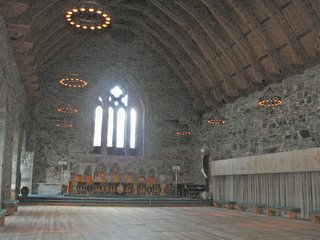 Interior of Håkon's Hall
Interior of Håkon's HallPerhaps more interesting, and certainly with much more to see, was the nearby Rozenkrantz Tower, a complex structure completed by the castle governor Erik Rozenkrantz in 1567 and incorporating two earlier defensive towers in a baffling maze of spiral staircases leading up to rooms with mullioned windows and massive stone fireplaces where the evidence of earlier floor levels was clearly visible in the walls. In one of the upper halls was a fascinating exhibition on the urban code of laws drawn up by King Magnus Lagobøte (the lawmaker) in the 1270s. Covering all aspects of shipping, town planning, theft and inheritance it drew both on earlier Norwegian codes and similar codes drawn up in southern Europe. It was particularly interesting to see from excavations in the Bryggen, Bergen's wooden waterfront buildings, how the code had been followed across the centuries, with regulation widths for streets and water cisterns provided by each building, as required by the code, to help fight fires.
At least one of those drawing up the code had studied law in Bologna, evidence of the wide intellectual, trading and cultural links of Norway in medieval times. Our own travels in Modestine fall into a more modest perspective compared with these earlier travellers. Finally we emerged on the roof of the tower, almost on the level with the top decks of the massive liner moored alongside, and with wonderful views over the harbour.
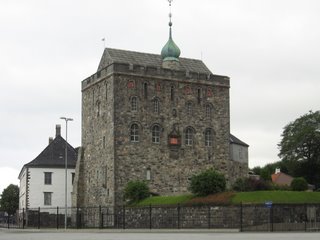 Rosenkrantz Tower, Bergen
Rosenkrantz Tower, Bergen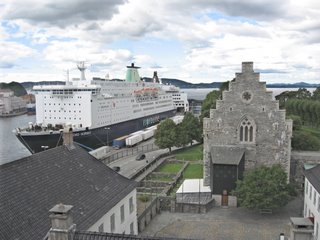 View from the top of the Rozenkrantz Tower showing Håkon's Hall and ship of the Fjord Line fleet
View from the top of the Rozenkrantz Tower showing Håkon's Hall and ship of the Fjord Line fleetFrom this quay we will soon be departing for home on a similar Fjord Line ferry
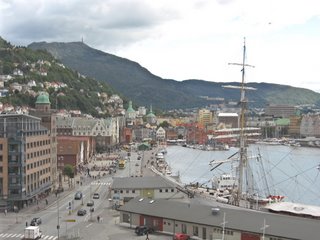 View from the top of the Rozenkrantz Tower back towards the city of Bergen
View from the top of the Rozenkrantz Tower back towards the city of BergenBy now the thought of pancakes and coffee lured us to the marketplace, only to discover there was no sign of the stall we had found on Monday. Nearby though was the tourist information centre, worth a visit just to see the 1920s frescoes covering the internal walls of what used to be the mercantile exchange, depicting the fishing industry around Lofoten, north Norway where fish is prepared and dried on frames before being transported south to Bergen to be sold. Other walls show ships arriving in Bergen loaded with cereals from foreign ports, and the construction of modern ships in Norwegian shipyards.
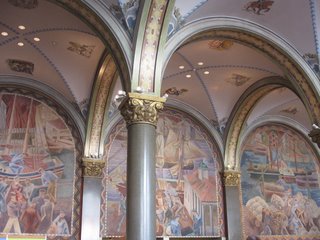 Frescoes in the Bergen tourist information office
Frescoes in the Bergen tourist information officeWalking through backstreets towards the bus station we found the public library, a surprisingly old fashioned place reminiscent of our early days working in Croydon Public Libraries, full of tall, dark wood shelving with a galleried main reading room. Here we used the internet briefly but there were queues of students waiting, so time was limited. In any case, our bus was nearly due.
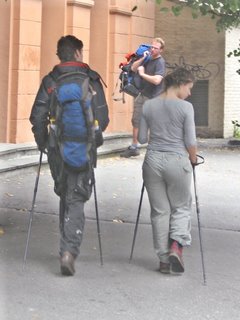 At last! We've finally found some real Nordic walkers!
At last! We've finally found some real Nordic walkers!Thursday 31st August 2006, onboard Fjord Norway
We have been heading south along the Norwegian coast all day, threading our way between the hundreds of islands, calling at Haugesund during the afternoon. As we approached the harbour we could see our former campsite near the base of the monument to Harald Fairhair, who united Norway during the 9th century. Soon we will be approaching Stavanger, where we originally intended to board the ship before we got tempted into travelling on to Bergen. We are glad we did. It has given us the chance to experience so much of Norway's beautiful scenery - its coastline, islands, fjords, mountains, clear lakes and glaciers. We have also been able to see some of the country's typical wooden towns - old Stavanger, the back streets of Bergen as well as tiny isolated hamlets on the islands or along the edges of inland fjords. Today's journey has allowed us to see the length of the coastline from the sea without it costing anything as the fare back to Newcastle is the same wherever the journey commences. Norway is predominantly green, its banks covered in dark green fir trees right to the edge of the grey rocks that plunge down into the sea. Beaches do not seem to exist at all. Overhearing other passengers returning from the classic trip northwards from Bergen, through the fjords and round the North Cape to Kirkenes, the scenery continues very similar the entire way. It seems we have been fortunate to experience at least a part of what is reputed to be the world's most magnificent journey.
 Looking back to Bergen
Looking back to Bergen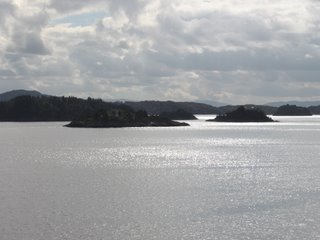 Offshore islands south of Bergen
Offshore islands south of Bergen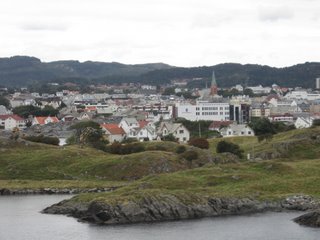 Arriving at Haugesund
Arriving at Haugesund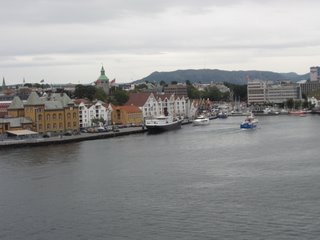 We arrive at Stavanger
We arrive at Stavanger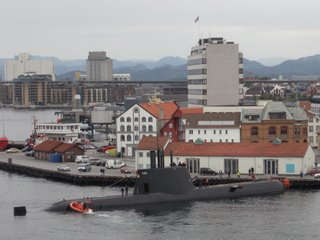 A German submarine arrives at Stavanger
A German submarine arrives at StavangerSince the 19th century the company of Hurtigruten has been trading between Bergen and the whalers, sealers and fishermen of the wilder and more remote parts of Norway right up into the Arctic Circle, running a regular service through the fjords and calling off at the islands to deliver grain, foodstuffs, medicines, tools and textiles to the islanders while collecting dried fish, cod liver oil, whale meat, animal skins and dried reindeer and elk flesh. It also carried passengers starting or returning from their travels through the port of Bergen. At some stage the company began to carry tourist passengers. It has now developed into a major tourist attraction carrying passengers for either a part of its total route, or up as far as Kirkenes and back again, calling off for a visit to the North Cape, and, depending on the season, a view of the Aurora Borealis or the midnight sun. Travellers are luxuriously accommodated on board ship and this must certainly be the most comfortable and convenient, if rather expensive, way of enjoying to the full the many splendours of this empty, lonely landscape.
Last night we slept in Modestine very near to the ferry terminal where we were kept awake for much of the night by the rain and the waves from passing ships slapping against the sea wall just feet from where we slept. We had no electricity so we are using that of the ferry company today to complete the events of our last day in mainland Europe which we spent around Bergen, visiting several of its museums, exhausting the last of our remaining kroner.
In the morning we visited the Hanseatic Museum housed in one of the old wooden buildings in Bryggen, the whole area being formerly the enclosed quarter of the German merchants. The Hanseatic League, with its headquarters in Lübeck, dominated trade in the northern seas from the 14th century until the 16th, and German influence in the northern outpost in Bergen lingered until the mid 18th century. The house with its heavy timbers was fitted out with many original features including the rows of bunks with sliding doors in which apprentices slept on straw mattresses. More senior staff actually had beds with hinged doors – even with pin-ups painted on the panels! It struck us that the traders of those days spent most of their life surrounded by timber beams – in their cabins on board ship, in their houses, even in their beds. There was some attempt at comfort with crudely painted decorations on the walls, portraits, and the odd piece of stylish furniture. There was also a passion for washing hands, with ewers, basins and roller towels in almost every room – very necessary when they spent so much time handling dried and salted fish, cod liver oil and pelts.
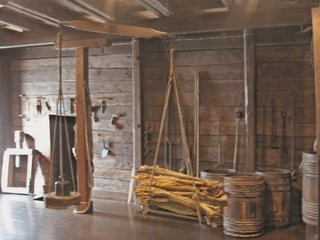 Stockfish being weighed, Hanseatic Museum, Bergen
Stockfish being weighed, Hanseatic Museum, Bergen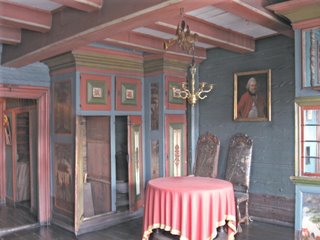 Room in the Hanseatic Museum, Bergen
Room in the Hanseatic Museum, Bergen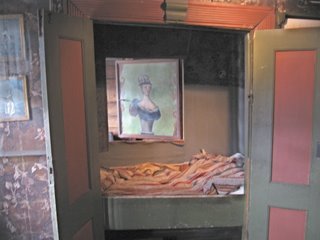 Bed with 18th century pin-up, Hanseatic Museum, Bergen
Bed with 18th century pin-up, Hanseatic Museum, BergenLife generally seems to have been hard and at the mercy of the sea. Ships from Lofoten, near the Arctic Circle, would deliver goods to Bergen and carry back necessities and more luxurious goods which had been received from Germany. Journeys south to Bergen could take anything from ten to 30 days and the journeys onward to Lübeck from 35 to 50 days. The small ships were often depicted on the seals of the towns with which the Hanseatic League traded.
 Ships depicted on civic seals, Hanseatic Museum, Bergen
Ships depicted on civic seals, Hanseatic Museum, BergenWe were also able to visit the Schøtstuene, the Hanseatic assembly rooms. Because of the danger of fire in the wooden buildings of the Bryggen, cooked food was prepared and hot meals were taken communally in a separate building. Some of the dues paid to merchants on cargoes in the port at Bergen were actually used to subsidise their annual feasts. The men, who had to be unmarried while they remained in Bergen, ate together on benches at long tables and some of the proceedings must have been quite rowdy. We saw pinned to the walls, the strict regulations, with fines for contravention, which were drawn up to regulate life in the assembly room.
 Schøtstuene or Hanseatic assembly rooms, Bergen
Schøtstuene or Hanseatic assembly rooms, Bergen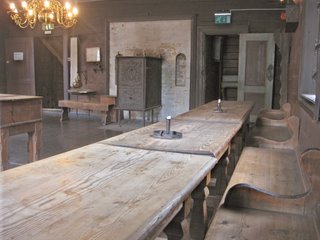 Interior of the Schøtstuene, Bergen
Interior of the Schøtstuene, Bergen Communal kitchen in the Schøtstuene, Bergen
Communal kitchen in the Schøtstuene, BergenLater in the afternoon we made our way to the Museum of Fine Art where we visited a couple of the galleries, one, the Rasmus Meyer Collection, containing works solely by Norwegian artists, the other, Lysverket, showing how the work of some was influenced by changing trends in Europe, particularly France, at the end of the 19th century. The first gallery included many 19th century paintings of towns and landscapes by Johan Christian Dahl and of course works by the world renowned painter Edvard Munch. Both these artists amazed us by the complete change of style between their early and later works. Dahl started with works that seemed to our untrained eye rather flat, pleasant but with no sign that he was a particularly talented painter. Then quite suddenly there was a transition to exquisitely executed landscapes showing great skill, depth and use of colour.
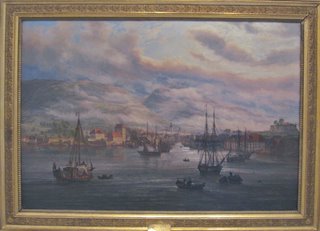 19th century view of Bergen by J. C. Dahl
19th century view of Bergen by J. C. DahlMunch on the other hand, started in his 20s with portraits showing complete realism and character. Suddenly, around 1900, his style changed with him producing canvases of bright solid colour influenced by Expressionism. Both were excellent but difficult to realise they were the work of the same artist. He was greatly influenced during his time in Paris by the works of the French Impressionists and this is also reflected in certain works where the colours are less dense and the outline far softer. It is interesting to note that he seemed capable of painting in completely different styles at the same period of his work.
Later, we crossed to the galleries of 20th century art where again there were examples of the work of both these artists. Here the flowing, impressionistic lines in Munch's paintings showed the development of his artistic style that lead to the searing anguish expressed so vividly in the Scream.
STOP PRESS… We are writing this in the lounge on the ship. The Norwegian news broadcaster on the overhead TV has just announced that Munch's world famous painting of the Scream which disappeared several years ago after being stolen from Oslo's art museum, has been recovered!!! Brilliant news and how strange that such news should reach us out on the North Sea as we write about the artist! We have verified our understanding with a member of the ship's crew who seems really delighted with the news.
The 20th century galleries also included several paintings by Miro and Picasso, including Picasso's 1960 depiction of the Bull Fight where the simple, vivid use of black and red caught Jill's attention across a room full of masterpieces.
Having spent most of the afternoon appreciating the zenith of Scandinavian culture, it ended with us experiencing its nadir when we investigated the inner depths of one of the tourist shops in the quayside. Here stuffed fluffy reindeer clutched tiny umbrellas (oh no, it looks like rain deer!), stuffed fluffy moose wore Scandinavian patterned woolly jumpers embroidered with "I love Norway", and large stuffed fluffy trolls sold for over £1,000 each." One of the trolls, realising we would soon be leaving Norway, asked Jill if he could have his photo taken with her wearing the new hat she's just bought. He assured us that the trolls of Scandinavia would always remember us with affection and though he was now too corpulent to pop down trollholes, some of his fellow trolls were already eagerly anticipating a cultural exchange with the pixies of Devon and might soon be seen popping up from beneath the manholes on Exeter quay.
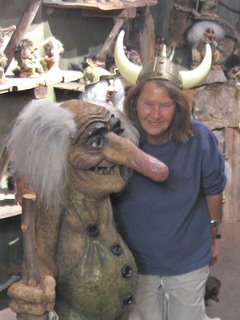 Jill (right) with troll
Jill (right) with trollAs we made our way back to Modestine at the end of the day we passed a young girl of about 12 with her mum busy removing cigarette stubs from one of Bergen's decorative manhole covers and photographing it. They came from Russia and were delighted to see such wonderful street art. In Russia, the young girl explained in delightful English, they do not have such beautiful things. When we told her we had photos of about 60 that we have seen in different towns, her eyes grew large with wonder and envy! So we, and the director of the museum in Comachio, are not alone in this new-found obsession!
Tomorrow morning we arrive in Newcastle. Originally Belgium was on our list of countries to visit during our gap-year, to see Ian's sister and family in Brussels. However, before we got around to it, fate intervened and they moved back to England to live in Kendal. So we still have one more visit to make on our way south as we return to our home in Exeter.
And so our year in mainland Europe finally comes to an end. It is a year that has taken us to 17 different countries stretching from Portugal in the west to Hungary in the east and from Gibraltar in the south to Norway in the north. We have seen many old friends along the way and made several new ones. Throughout we have been supported by the interest of friends and family who, with a regular flow of emails, have ensured we never feel homesick. Modestine has behaved superbly suffering no more than a couple of punctures, two dud light bulbs and a burned-out glow plug.
We leave behind us a scattering of Ian's mislaid sunhats and a final message that says it all, written in the soft sand beside the boathouse on the furthest tip of Norway's island of Holsnøy.
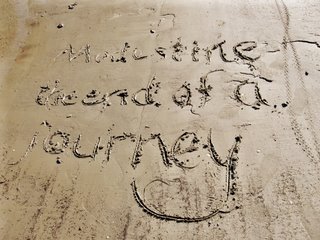 Modestine, the end of a journey
Modestine, the end of a journey